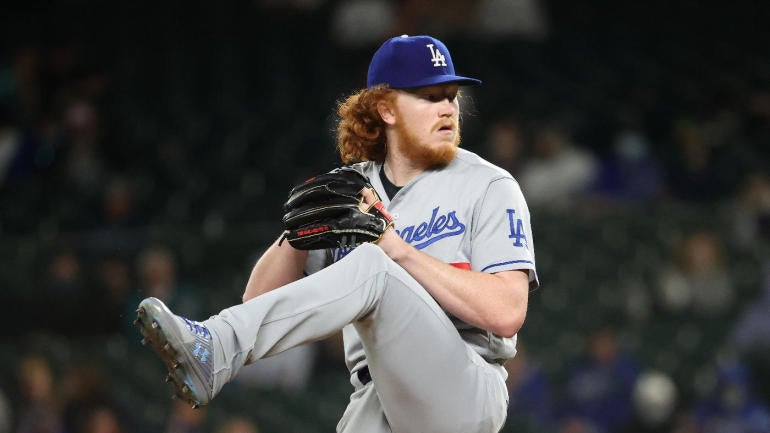
The 2021 MLB regular season is roughly four weeks old and although I know no one wants to hear it, it's still very early. How early? So early that there are still two qualified hitters (Mike Trout and Yermín Mercedes) hitting over .400. As a general rule of thumb, you can keep saying it's still early as long as someone is hitting .400.
Anyway, our weekly series breaking down various trends across the league continues with a look at a young pitcher taking his game to the next level, one team's struggles with MLB's new rules, and a check in on pitchers hitting. Last week we broke down Justin Turner's uncharacteristically big April and the Rays' free-agent pitching additions.
Dustin May, now with strikeouts
Visually, few pitchers in baseball are as impressive as Los Angeles Dodgers righty Dustin May. The 23-year-old is long and lanky, built more like Waluigi than a baseball player, and he unleashes an arsenal that includes a 100-mph sinker, a mid-90s cutter, and a mid-80s curveball with an exceptionally high spin rate. May is the prototypical power pitcher in the year 2021.
Thanks for signing up!
Keep an eye on your inbox.
Sorry!
There was an error processing your subscription.
Despite the raw stuff, May has not missed as many bats as you'd expect in his MLB career. He posted a 20.8 percent strikeout rate and an 8.5 percent swing and miss rate in 90.2 innings from 2019-20. The MLB averages were 23.4 percent and 11.4 percent, respectively. May's swing and miss rate was the same as Iván Nova's and Jordan Zimmermann's the last two years.
The strikeouts have arrived this year. May has fanned 32 batters in his 21 1/3 innings, and he's sitting on a 37.2 percent strikeout rate and a 14.1 percent swing and miss rate. Last year he struck out his 32nd batter in his 45th inning. This year he did it in his 21st inning. On Sunday, May became the youngest Dodgers pitcher with a 10-strikeout game since Clayton Kershaw in 2011.
May's strikeout and swing and miss rate improvements can be attributed to a few things. First, he's tweaked his pitch mix slightly, specifically throwing fewer sinkers and more four-seam fastballs. From 2019-20, May threw 51 percent sinkers and 6.0 percent four-seamers. This year it's an even split with 18.2 sinkers and 18.2 four-seamers.
Four-seam fastballs are a better swing and miss pitch than sinkers, particularly when thrown up in the zone. May is also throwing a few more cutters and curveballs as well. Simply put, he's being more unpredictable. Here's what May told Mike DiGiovanna of the Los Angeles Times about his pitch mix earlier this month:
"Just being able to mix my pitches more [will help]," said May. "I've been so fastball dominant down in the zone with my sinker, and [the hitters] kind of got a good idea of that — they know it's my go-to pitch. So being able to mix some breaking balls down in the zone and flash some heaters up has been really good."
And second, May is locating his sinker better. Last year he posted a 42.9 percent edge rate with his sinker, meaning it was on the edges of the zone about 43 percent of the time. The other 57 percent it was in the middle of the plate or well out of the zone. This year May has upped his sinker edge rate 51.1 percent. Here are May's sinker location heat maps:
Much better. May is avoiding the middle of the plate with his sinker this season and, not coincidentally, his swing and miss rate on the pitch has jumped from 11.4 percent last year to 19.4 percent this year. The MLB average on sinkers is 17.4 percent, so May has gone from well below average to comfortably above average in a year's time.
Furthermore, May hasn't sacrificed ground balls or weak contact to get more strikeouts. His 57.4 percent ground ball rate is better than his 50.8 percent rate from 2019-20, and his 88.8 mph average exit velocity allowed is about league average. May is still doing the things that made his effective the last two years, only now he's pairing it with one of the highest strikeout rates in the game.
Twin struggling with MLB's new rules
It has been a difficult few weeks for the Minnesota Twins. Since their 5-2 start to the season, they've lost 13 times in 15 games, and have been outscored 84-46 in the process. The losses have been increasingly soul-crushing too. Last week they committed back-to-back errors in a walk-off loss to the A's, and earlier this week Alex Colomé served up a walk-off homer to Cleveland.
Colomé signed a one-year deal worth $6.25 million over the winter and has been a disaster. He's allowed 15 runs (only eight earned because of the extra innings rule) in 8 2/3 innings, and he's already been tagged with three blown saves and three losses. Colomé's minus-2.18 win probability added is the worst in baseball by more than half a win. He's been dreadful.
It takes a total team effort to go 2-13, however. It's not all on Colomé. The Twins have been banged up a bit, Luis Arraez and Nelson Cruz are the only regulars who've stayed in the lineup and hit consistently, and 2020 AL Cy Young runner up Kenta Maeda has a 6.56 ERA in five starts. The Twins are bad at everything right now. Add it up and you get 13 losses in 15 games.
Minnesota has also been hurt by MLB's new rules. When they play anything other than a traditional nine-inning game, they're losing. Check it out:
- Extra-inning games: 0-5
- Seven-inning doubleheader games: 0-4
- Regular nine-inning games: 7-6
Going 2-6 in one-run games hasn't helped matters either. Last year the Twins went 3-1 in extra-inning games with the automatic runner at second base, and 4-4 in seven-inning doubleheader games. They weren't great in those new rules games, though they were at least competitive. This year those games have been an automatic L.
"The number of extra-inning games and the number of these types of ballgames that we've played through the first 21 games is almost not believable," manager Rocco Baldelli told reporters, including MLB.com's Do-Hyoung Park, earlier this week. "I mean, it's pretty crazy ... All of our ballgames are not going to play out like this, but when we do have them, we've got to know we can go out there and win these kinds of games."
Is there a secret to being a good extra innings team or a good seven-inning game team? I don't think so, or at least I don't think we have enough evidence to say so definitively. Extra-inning games are essentially coin-flip games that could go either way, and they simply haven't gone Minnesota's way yet. Seven-inning games are a different animal, but they haven't gone their way either.
The season is still young -- the Twins still have 140 games to play! -- but they've done real damage to their postseason odds with this 7-14 start. Their postseason odds have dipped from 71.8 percent before the season to 18.9 percent now, according to SportsLine, and their AL Central title odds have dipped from 52.8 percent to 10.3 percent. They're seven games behind the Royals. Seven!
Minnesota's issues extend far beyond extra-inning games and seven-inning doubleheader games. Too many important players are performing below expectations and Colomé seemingly blows the few leads the Twins are able to build. Losing all the new rules games hasn't helped matters. Maybe their luck will change soon, though those losses have already done a lot of damage.
Pitchers are hitting worse than ever
MLB commissioner Rob Manfred is unwilling to do anything that is in the best interests of the game without receiving something of value in return from the MLBPA, and because of that, there is no universal DH this year. MLB wants it, the MLBPA wants it, front offices want it, and majority of fans want it, but nope, we don't have it because Manfred is using it as a bargaining chip.
Predictably, pitchers have been terrible at the plate this year. I mean, they're always terrible at the plate, but they're even worse than usual this year. They don't train to hit and they all took a year off from hitting last season. Of course they're going to come back and be bad and rusty at it. Only the great Jacob deGrom (6 for 11 at the plate) is contributing to his team offensively.
Going into Tuesday's action pitchers were hitting .111/.139/.140 with a 46.3 percent strikeout rate in 643 plate appearances this season. That is 122 percent below league average once adjusted for ballpark and things like that. There's still a lot of season to play out, though that slash line is on pace to set all-time lows across the board. The current record lows:
- .115 batting average in 2018
- .144 on-base percentage in 2018
- .148 slugging percentage in 2018
The eight lowest pitcher batting averages have come within the last 10 seasons, the seven lowest pitcher on-base percentages have come within the last 10 seasons, and the seven lowest pitcher slugging percentages have come within the last 10 seasons. So, the seven worst pitcher hitting seasons ever have all come within the last decade. It's not a coincidence. It's a trend.
This was avoidable. The universal DH is not nearly as significant a bargaining chip as Manfred seems to believe (it's 15 low-value jobs with no extra roster spots), and rather than protecting pitchers from unnecessary injury risk and getting more offense into the game, we're stuck with pitchers hitting. Hitting worse than ever too, and there's no reason to expect them to get better. History tells us they're only going to get worse.
"may" - Google News
April 28, 2021 at 10:13PM
https://ift.tt/3nuHjET
MLB trends: Dustin May unlocks potential; pitchers hitting worse than ever; why one team must hate new rules - CBS Sports
"may" - Google News
https://ift.tt/3foH8qu
https://ift.tt/2zNW3tO
Bagikan Berita Ini


















0 Response to "MLB trends: Dustin May unlocks potential; pitchers hitting worse than ever; why one team must hate new rules - CBS Sports"
Post a Comment